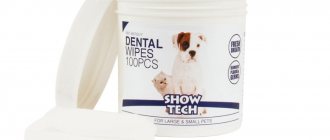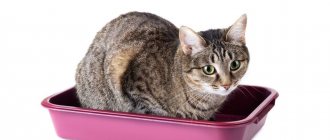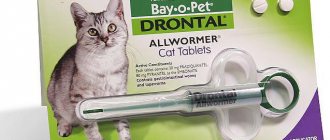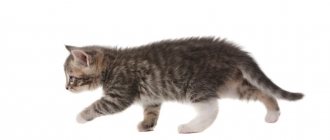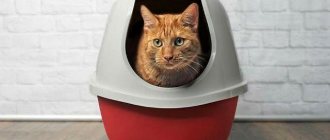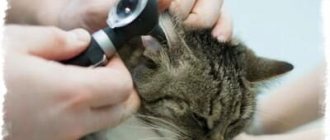Representatives of felines have acute hearing and can hear the slightest movement or movement of the victim while living in their natural environment. With its help, cats are well oriented in space in an unfamiliar area and can accurately determine the distance to the sound source and its direction.
If a cat's ear canal becomes dirty, the animal experiences significant discomfort, loses a number of natural abilities, and becomes more vulnerable. Dirt can provoke the formation of sulfur plugs or cause an inflammatory process. Today we will talk in detail about whether cats can have their ears cleaned, how to do it correctly, what a healthy ear looks like, and in what situations it is necessary to contact a veterinarian.
How often to check
Ideally, a preventive examination of the pet’s ear should be carried out every day or once a week, accustoming it to this procedure from early childhood. This is easy to do; while your pet is lying in your arms or carelessly playing with his favorite toy, carefully and carefully bend the edge of the ear and look inside. If the animal is healthy, the shell should be a soft pink color, there should be no dirt in it, and minor sulfur deposits are allowed.
Some cat breeds require more frequent and thorough preventive examinations due to the anatomical features of the structure of the auricle. Animals with large ears get their ears dirty faster than usual; these breeds include:
- Maine Coons;
- Abyssinian breed;
- Devon Rex;
- Somali cats;
- Scottish Folds and others.
Cats that do not have fur inside the ear canal are susceptible to active production of wax to protect against dust and dirt getting inside.
Devon Rex and other breeds with short or no hair need regular ear hygiene.
Features of the structure of the animal's auricle
A cat’s ear, like a person’s, consists of 3 sections:
- External: a funnel-shaped auricle, covered on the inside with a small amount of guard hairs and on the outside with hair, and the external auditory canal.
- Middle: includes the eardrum and the bony tympanic cavity, where the 3 auditory ossicles are located. They play one of the leading roles in the perception of sound.
- Internal: hollow bone formation in the temporal bone, the most complex section. It contains the receptor channels of hearing and the vestibular apparatus.
In humans, the auditory canal is straight and short, but in cats it bends and runs slightly at an angle. Due to ignorance of this feature, during cleaning you can create a sulfur plug that will block the passage.
The cat's ear can detect vibrations from 20 to 100,000 Hz. With the help of muscles and cartilage, the auricle rotates in different directions, which allows you to accurately determine the source of sound. All this makes animals excellent hunters.
Earwax formation and its role in the ear canal
The formation of sulfur is not a pathology, but a natural process. The ear secretion performs several important functions:
- lubricates and moisturizes the skin in the ear canal;
- provides protection against bacteria and fungi;
- prevents the ingress of dust, hair and skin particles, and insects.
All debris that enters the ear, thanks to the sulfur, clumps and comes out naturally. The cat brushes off the residue while washing.
If the production of wax is impaired, pathogenic bacteria easily enter the ear, causing animals to develop:
- otitis;
- dermatitis;
- otomycosis (fungal infection) and other diseases.
In healthy animals, earwax has a paste-like consistency, is light brown in color, and has virtually no odor. Changes in color, thickness, or the appearance of an unpleasant odor indicate the onset of the disease.
Cleaning a cat's ears - what you need
How to clean a cat's ears and how long does it take? For hygienic cleaning you need 10-15 minutes of time, a little patience, and also:
- soft discs or cotton swabs;
- cotton swabs with a limiter for children;
- special products for gentle, safe cleaning, sold in specialized veterinary stores.
Cotton pads or swabs are used to pre-treat the sink and evacuate large dirt and dust; with the help of cotton swabs, it is possible to capture sulfur and dirt.
To reduce the time of hygiene measures, veterinarians recommend using special lotions.
Their action is aimed at softening sulfur deposits and facilitating their evacuation. Lotions and drops for cleaning ears do not irritate delicate skin, have a pronounced antibacterial effect, do not cause an allergic reaction, and effectively eliminate unpleasant odors.
General symptoms
All diseases of the hearing organs have a different nature of occurrence and course, so it is difficult to say how to treat a cat’s ears without knowing the exact diagnosis. You can suspect a problem in a furry pet based on several signs:
- Dark plaque on the inside of the ear;
- Change in the color of sulfur in a cat;
- Itching of the ears, trying to relieve which the animal rubs against the corners of the furniture and or pulls the ears with its paws;
- Unpleasant odor from the ears;
- Redness and irritation of the inner ear area;
- Formation on already rashes and sores.
If such symptoms appear, you should take your pet to a doctor. Only after an examination and appropriate diagnostics, a veterinarian will be able to say exactly how to treat a cat’s ears in a particular case.
How to clean a cat's ears at home without causing harm
In order not to cause emotional and physical trauma to the cat, you need to act carefully and slowly. You cannot hold an animal by force, use force, and, especially, scold it.
In addition, it is strictly forbidden to use ordinary hygiene sticks and, even more so, to clean the cat’s ears with matches or tweezers wrapped in cotton wool. This can lead to the following consequences:
- the cat may involuntarily jerk its head, which will lead to injury to the delicate tissue of the ear;
- the wound cotton wool may accidentally end up inside the ear canal;
- the hard end of a match or tweezers can scratch the passage and cause infection of the wound.
It should be noted that the epithelium of the pet’s ear canal is very delicate and can easily be scratched due to careless movements or too deep penetration of the stick. If its integrity is damaged, there is a risk of disrupting the natural ventilation of the hearing organ. As a result, humidity levels increase, and in such an environment the risk of developing a bacterial or fungal infection is high.
What causes ear contamination?
Accumulations of earwax are dangerous not only because they cause various pathogenic health disorders and cause a decrease in hearing acuity.
Accumulations of sulfur create a favorable environment for the activity of pathogenic bacteria and fungi. They often become the cause of various local inflammatory processes and contribute to the development of otitis media.
Also, cats whose owners do not consider it necessary to clean their hearing organs are more susceptible to parasitic diseases; they are much more likely to become victims of ear mites, that is, they become infected with otodectosis.
How to clean a cat's ears - preparation
Don't expect your cat to be happy about your desire to do ear hygiene. Cats are capricious animals and can show their character as a sign that they do not like the procedure. In order to develop a calm attitude towards cleaning, you should accustom the animal to hygiene measures, as well as to water procedures, from childhood.
Before you start cleaning, create a calm environment, make sure that the animal is fed, satisfied and in a good mood. Place your pet in your arms or place it comfortably on the floor, be gentle with her, stroke her periodically, speak gentle words, stop for a while, give your pet a break.
If the cat is nervous or worried, veterinarians advise to restrain it; for this you can use a thick terry towel. By leaving only the muzzle outside, you will prevent the kitten from scratching or biting itself, and will also protect it from mechanical injuries. If you can’t cope alone, you can use a second person, then one participant will be responsible for fixing, and the second will carefully clean the ears.
What special products should you use when cleaning cat ears?
The choice of ready-made special products designed to keep cat ears clean is quite large. Manufacturers of pet products offer not only lotions or disinfectant solutions, but also gels, drops, and oils that can carefully “dissolve” sulfur deposits, soften them and simplify the cleaning procedure. Wet wipes for cleaning the hearing organs of animals are also available in veterinary pharmacies and pet stores.
Which ear lotion for cats should you choose? Among the pet products produced by domestic manufacturers, the following brands have proven themselves well:
- "Dewdrop".
- "Leopard".
- "Otoklin".
If the animal owner wants to use imported ear lotion, the following are suitable for cats:
- Leo Cat Cleaner.
- Otifree.
The entire Hartz product line is famous for its good reviews from pet owners.
What to pay attention to during the cleaning process
Now you know how to clean a cat’s ears and how to clean a cat’s ears so that everything goes smoothly. As it turned out, the procedure does not require special knowledge, does not last long, and is not accompanied by pain or severe discomfort. At the same time, there are situations when it is impossible to carry out hygiene measures without the help of a veterinarian:
- the cat suffers from hearing impairment;
- the integrity of the auricle is compromised as a result of injury;
- there is a fungal infection, there is an inflammatory process;
- there is a suspicion of ear mites;
- there is a white coating, spots, rashes inside;
- There is an unpleasant fetid odor and copious discharge.
In addition, doctors do not recommend cleaning cats’ ears if the pet often shakes its head, scratches its ears, tilts its head to the side when walking, and exhibits other alarming symptoms.
In such cases, cleaning cats’ ears on their own is contraindicated; the animal must be urgently shown to a veterinarian who knows for sure how to wash a cat’s ears. The doctor will examine the auricle with an otoscope, assess its condition, and, if necessary, prescribe laboratory tests and additional studies.
Treatment
If brown spots in a cat’s ears appear due to illness, then the treatment will be determined by a veterinarian:
Otodectosis. Mechanical cleaning of mites, crusts, plaque using antiseptics (hydrogen peroxide, Furacilin, camphor alcohol). Treatment with an acaricidal agent (Ivermectin, Stronghold, Otoferanol, Acaromectin) in the form of drops and ointments. After applying the medicine, the ears are easily massaged to absorb the medicinal components. To stimulate the immune system – Immunofan, Ribotan. The cat is transferred to balanced feeding. If a purulent infection develops, use antibiotics.- Otitis. Cleaning the ear surface and external auditory canal from secretions, crusts, dirt with an antiseptic solution (Chlorhexidine, Miramistin, Furacilin, hydrogen peroxide). Then the medicine is instilled (Aurikan, Surolan, Otibiovet, Tsiprovet). For purulent otitis - antibiotics (Amoxiclav, Cefazolin, Azithromycin). To stimulate the body's defenses - Gamaprene, Salmozan.
- Fungal diseases. After cleaning, antifungal ointments are used - Clotrimazole, Panolog, Oridermil. Oral medications are prescribed - Ketoconazole, Amoxicillin.
The appearance of brown plaque or discharge in the ear is a warning sign. Often this occurs due to insufficient care, then there is no serious danger to the pet’s health. If the formation of dirt is accompanied by other symptoms, then the matter is the development of the disease.
When to use ear drops that soften wax deposits?
In veterinary pharmacies, among the cat ear care products there are also drops, the use of which makes the procedure easier, since the drugs soften hardened wax deposits.
When should they be used? Many pet owners instill the drug before starting the ear cleaning procedure. However, this is not necessary. Moreover, preliminary instillation can force the animal to intensively scratch its ears, since the softening of the wax plug is accompanied by itching.
It is more advisable to use droplets directly during the cleaning procedure. The drug should be instilled after the previously cleaned ear is folded back. While the owner removes dirt from the convolutions of the sink, the droplets will work, and the process of cleaning the channel will be much easier. Manipulations carried out by humans will relieve the cat’s desire to scratch his ear, which accompanies the action of the drops.




